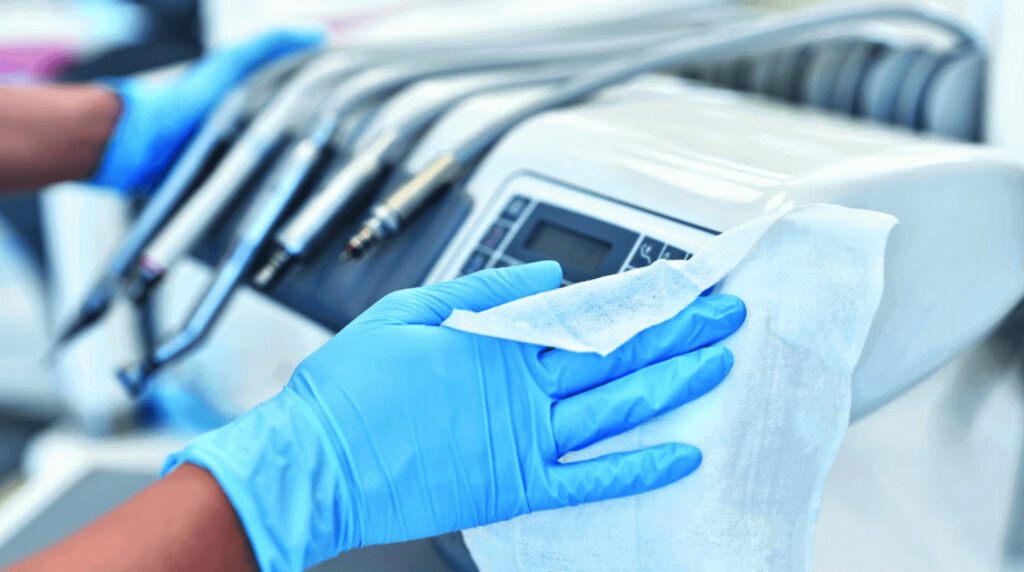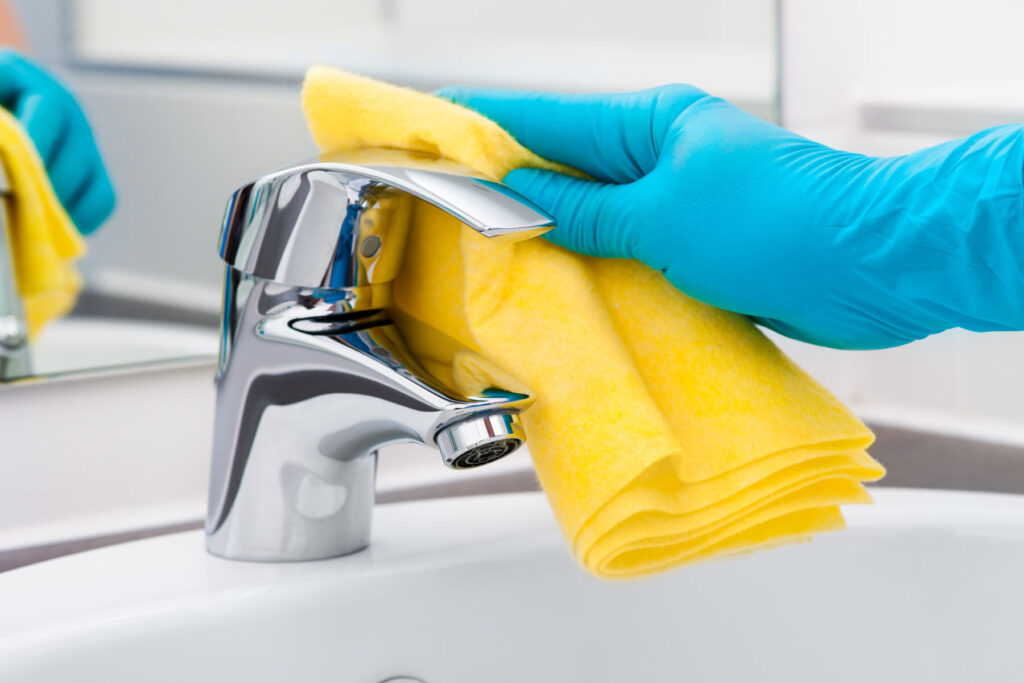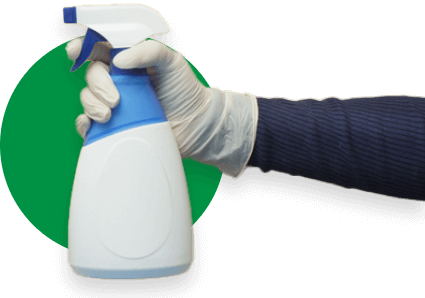For the safety of dentists, nurses, and patients, every facility must follow comprehensive disinfecting and dental clinic cleaning routines. In addition, these last number of years emphasize the need for proper safety measures. As with any medical facility, dental clinics must be kept as sanitary as possible. This is because unclean dental equipment can lead to infection. In turn, this can result in people becoming sick. Luckily, this unfortunate scenario can be avoided with the implementation of proper health and safety measures.
In this article, we will detail an expert guide on effectively disinfecting a dental clinic.
Understanding the Key Areas for Disinfection in a Dental Clinic
Understandably, it is essential to keep the entire dental clinic clean and sanitary. However, there are specific key areas that require more attention. Typically, these are locations with the highest frequency of interaction. Therefore, they are more vulnerable to harboring harmful microorganisms. In order to prevent the spread of germs and infection, these locations should be routinely disinfected.
To start, you must disinfect high-touch surfaces in the treatment room. These are places with the greatest amount of human contact. For example, patient chairs and armrests should be properly disinfected after each appointment. Individuals should feel safe at the start of their appointment. In addition, you can place a thin transparent cover on the patient’s chair. While this is not mandatory, it will help prevent the spread of harmful microorganisms.
Furthermore, all medical equipment must be properly disinfected after each use. In fact, certain critical items may require stronger types of disinfection. To continue, all sinks should be disinfected multiple times per day. This also holds true for any handles, doorknobs, and light switches.
Along with treatment rooms, reception areas must be effectively disinfected. Since this is the location where individuals enter and wait, it is crucial to maintain a strong level of cleanliness. Also, there are items that people routinely touch. If they are not consistently disinfected, there is a risk of infection and germ-spreading. In particular, chairs and tables should be disinfected with an alcohol-based wipe or spray.
Likewise, if any tablets are used, they should be cleaned after each use. In addition to preventing the spread of viruses and bacteria, a clean reception area can significantly improve patient morale. Individuals will feel more comfortable in a space that is safe and healthy.
Lastly, you must disinfect all bathrooms in a dental clinic. Typically, these are places with the highest amount of harmful microorganisms. In addition, bathrooms contain a variety of high-touch surfaces. To start, all toilets and urinals should be cleaned with a suitable solution. Afterward, flushes, sinks, and door handles must be properly disinfected with an alcohol-based wipe. Usually, surfaces like these should be disinfected multiple times per day.
Once that is complete, refill the paper towel, toilet paper, and soap dispensers. By doing so, you can maintain clean and safe restrooms in your dental clinic.

Developing a Comprehensive Disinfection Plan
Now that you understand the importance of disinfection in dental clinics, it is time to develop a comprehensive disinfection plan. This should be a well-thought-out daily routine. Furthermore, it should be separated into three sections:
- At the beginning of the day
- In-between patient visits
- At the end of the day
With the implementation of proper disinfection of the dental clinic schedule, your facility will be safe and sanitary.
The period of time before opening hours is crucial for medical facilities. Since there are no patients, there is time for the disinfection of the dental clinic. To start, all contact surfaces must be disinfected. In addition, you should inspect all medical equipment and ensure they are safe for patients.
For absolute safety, all dental instruments should be flushed with water for at least 2 minutes. This will allow proper contact time. In addition, you must clean all suction lines with a suitable disinfectant. Again, there should be at least 2 minutes of exposure time. This is a relatively easy process and will help protect patients, nurses, and dentists. Also, you can check bathrooms and guarantee that everything is fully stocked.
To continue, there are disinfection procedures you must follow in between patient visits. The most important task is disinfecting dental clinic instruments and contact surfaces. In particular, any device that is used on a patient must be flushed for at least 2 minutes. They will require a high-level disinfectant. Specific equipment may require sterilization and a stronger sanitation process.
Moreover, if there is a protective cover on the patient chair, it must be replaced after each visit. Also, armrests should be cleaned with a low-level disinfectant. Similarly, noncritical surface items must be sanitized with this type of disinfectant. Finally, dentists and nurses need to put on protective wear after each visit.
Lastly, there are disinfection tasks that must be performed at the end of the day. Typically, this will include wiping the reception area with a low-level disinfectant. In addition, all waste bins should be emptied.
As it relates to the treatment room, all dental equipment must be properly flushed. In fact, critical equipment should be sterilized. Depending on the device, it will need to be put in the autoclave or through dry heat sterilization treatment. Furthermore, the outlet and suction filter should be cleaned. These tasks will not only keep your dental clinic sanitary, but they will also help prevent cross-contamination and the spread of harmful pathogens.
It is important to note that all staff members must be properly informed about disinfection in dental clinic procedures. If not, individuals can be at risk of infection. You can ensure the safety of your facility by emphasizing the importance of scheduling and disinfecting dental clinics.
In addition, all dental clinics must abide by OSHA (Occupational Health and Safety Administration) regulations. For example, all employees must complete infection control training once per year.
Selecting the Right Disinfectants and Cleaning Agents
Before we explain the different types of disinfectants used in dental clinics, it is important to state the differences between disinfecting, sanitizing, and cleaning. Often, these terms are used interchangeably. However, they have varying levels of strength and effectiveness. In fact, certain methods should be implemented on different items and surfaces.
To start, cleaning is the removal of visible dirt and debris. Typical cleaning items are soap and warm water. In general, this is done to improve the appearance of an item or surface. While it can remove some germs, it does not do so at a sufficient level. However, cleaning is still an important procedure as it should be done before disinfecting dental clinics.
Conversely, sanitizing is eliminating harmful microorganisms to a satisfactory level. Public health entities will determine what qualifies as a safe standard. Common types of sanitizing products are low-level chemical-based solutions and anti-bacterial wipes. Depending on your dental clinic, this method can be used for low-risk noncritical surfaces.
Finally, there is disinfection. This is the process of killing all harmful pathogens (viruses, germs, and bacteria) from an item or surface. Disinfectants used in dental clinics tend to contain alcohol, chlorine compounds, or hydrogen peroxide.
To continue, when you decide on which disinfectant to use, you should assess a variety of factors. First, the product must be registered and approved by the EPA (Environmental Protection Agency) and FDA (Food and Drug Association). If not, it will not be suitable as it can pose risks to patients and staff members.
Afterward, you should confirm their effectiveness. For example, you should not use a low-level disinfectant on critical instruments or high-contact surfaces. Also, you must take contact time into account. Different disinfectants will require varying amounts of exposure time. If instructions are not followed completely, it may lose effectiveness.

Proper Cleaning and Disinfection Routines
The disinfection process includes several different steps. While it may seem overwhelming, it is of vital importance. In particular, dental instruments and equipment are high-risk and high-priority items. Therefore, they must be disinfected with absolute care and safety.
Before you begin the disinfection of dental clinic equipment, you should clean them. This will remove noticeable dirt and will increase solution effectiveness. Afterward, you must follow instructions and properly apply the disinfectant to the item. Then, you need to allow the recommended contact time.
Finally, wipe the equipment with a microfiber cloth. It is important to note that all items must fully dry after disinfection. This will prevent the contact of human skin and harsh chemicals.
Likewise, anyone who is tasked with disinfection responsibilities must wear protective wear at all times. This is mandatory and a crucial safety precaution. Typically, you must wear gloves, eyewear, and face masks. If a disinfecting solution contacts the skin, strong irritation may occur. Also, you are keeping the equipment safe from any harmful pathogens.
Understandably, dental clinic cleaning and disinfection is an important process that requires a great amount of knowledge and skill. At Dallas Janitorial, our team of professionals has the ability and resources needed to disinfect your dental clinic effectively.
Frequently Asked Questions
Why is disinfection so important?
Disinfection is the process of killing all harmful microorganisms, such as viruses, germs, and bacteria. It is so important because it helps prevent individuals from becoming sick or infected.
As it relates to dental clinics and medical facilities, this level of importance increases exponentially. Every device or instrument used in any healthcare facility must be properly disinfected after use. In addition, certain critical equipment may require sterilization, a stronger sanitation method.
What is the proper way to use dental disinfectants?
The best way to use dental clinic disinfectants is by completely following the instructions on the label. Understandably, item manufacturers will know the proper way to use their products. Therefore, it is essential to follow those guidelines precisely. If not, dental clinic disinfectants may not be as effective or may pose risks to those using them.
Usually, it is best to hire professional help when disinfecting dental clinic equipment, as they are experts. That way, they can ensure safety and effectiveness.
How to choose dental unit disinfectants?
When choosing dental clinic disinfectants, it is important to focus on the items, surfaces, and level of strength needed. For example, critical equipment will require high-level disinfection or sterilization. Alternatively, you should use low-level disinfectants for non-critical items. Also, you may have a brand preference for certain products. This is fine. However, you should ensure its effectiveness before applying.
In addition, specific disinfecting solutions may require longer exposure and contact time. If this becomes an issue, it may be best to use a different product.
What to look for in a disinfectant?
To begin with, you should evaluate the safety of the product. In addition to being safe to handle, it must be suitable for patients, nurses, and dentists. If anyone is at risk of irritation or health hazards, that product should not be used. Furthermore, you should confirm that the product will kill all harmful microorganisms.
In general, you should opt for a disinfectant that is effective and safe to be around.
What is surface disinfection, and why is it important?
This type of disinfection is the process of eliminating unhealthy viruses, germs, and bacteria from a surface. Understandably, in a dental clinic, this is very important.
Surface disinfection is done to prevent the spread of harmful microorganisms from surface to surface or from person to person. In addition, there are different levels of disinfectant solutions. Typically, the right surface disinfectant for dental clinics is strong. Furthermore, it is always important to use EPA-registered products.
These are tested and will be effective in keeping individuals safe. It should be stated that high-level dental clinic disinfectants are not safe for most surfaces as they contain various harsh chemicals.
How Dallas Janitorial Services Can Help
Dental clinic cleaning should be of utmost importance. By doing so, you can prevent dentists, nurses, and patients. In addition to keeping everyone safe, it can also significantly improve a clinic’s reputation. However, the disinfection of dental clinics requires expert-level knowledge and ability.
For the best results, consider hiring Dallas Janitorial Services. Our team of qualified and superb staff members can ensure the cleanliness of your dental clinic. To schedule an appointment, please call us at 214-778-3689.







